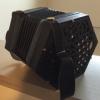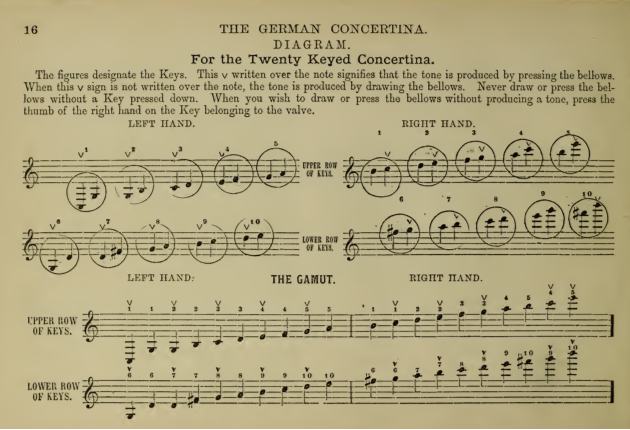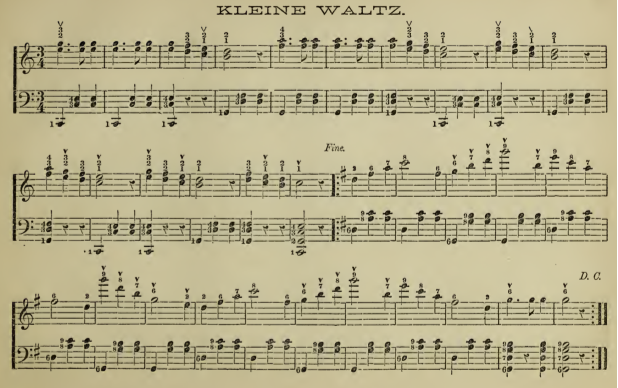-
Posts
98 -
Joined
-
Last visited
Everything posted by MJGray
-

Concertinas At Sea: A History Of A Nautical Icon
MJGray replied to Dan Worrall's topic in General Concertina Discussion
And well worth your time they are, too! Here are the Google Books links: Volume 1 = https://www.google.com/books/edition/The_Anglo_German_Concertina/1-thWE5XRmsC Volume 2 = https://www.google.com/books/edition/The_Anglo_German_Concertina/JKZO1aevsiIC Thanks for writing them, Dan! I very much enjoyed reading them when I was first picking up the concertina. -Mike -
Well, to an extent, but every choice of instrument is also a choice of repertoire, and a musician's choice of instrument does reflect that taste and inner desire. A piano is not a sitar is not a kora is not an shamisen, etc. etc. I pick up the banjo for a very different set of tunes than I pick up the concertina, and those are both pretty solidly set in Western musical traditions. I honestly don't think it's a weakness of an instrument to be better at some things than others. Genuine virtuosos can transcend those limitations, but each instrument has strengths that lend themselves to particular kinds of music. So I suppose my answer to the OP's question is "I don't", and will either transpose into a key that works or play a different instrument better suited to that particular tune. I make no pretensions of virtuosity, though 🙂
-
Sadly, I've never known any substitute for repetition for instilling muscle memory. However, a little research suggests that there are ways to do a better job, largely by careful structuring of those repetitions. A couple of interesting links that have me thinking about ways I can improve my own practice: https://www.washingtonpost.com/news/wonk/wp/2016/02/12/how-to-learn-new-skills-twice-as-fast/ https://www.guitartricks.com/blog/Improve-Muscle-Memory-With-These-8-Easy-Tips
-
I bought a Clover from Bob a few years ago and have been very happy with it. Mike
-
This might help: https://www.bushtraditions.org/tutors/concertina.htm There's a pinned thread called "Instruction Books for Concertina" in the Teaching and Learning forum that has a much more extensive list of available resources.
-

Beginner help - Anglo or Hayden Duet?
MJGray replied to Darabin's topic in General Concertina Discussion
I have no idea about duet concertinas (others will be far more helpful there), but it's certainly true that there are many more resources for learning the Anglo. As long as you're not too concerned about playing easily in multiple keys, the Anglo sounds like it would fit your needs pretty well. -

How to Add Depth/Richness When Using Music Not Written For Concertina
MJGray replied to Smcd's topic in Teaching and Learning
To add one little trick that I've found both easy and useful: playing the melody in octaves adds a nice richness to a simple tune, and is straightforward on the 20b Anglo (certainly easier than bass lines and chords!). https://www.concertinajournal.org/House_Dance_Text/ch_2.htm -
Glad you found it entertaining! I have to admit I didn't notice the left hand notes being transposed an octave down, because I learned to read music as a clarinet player in junior high and never had any cause to use a bass clef. 🙂
-
Well, that's very interesting. I like it. I would probably add some button numbers, but it didn't occur to me to change the shape of the note heads. That would make it so you only needed numbers 1 - 5, even for a 3-row instrument. Just what we needed: another tablature system! 🙂
-
Me too! The "notated clearly" is definitely a key part. There have been some real historical failures on that front. I've been digging through more old books, and Carlo Minasi (https://archive.org/details/imslp-book-for-the-use-of-learners-of-the-german-concertina-minasi-carlo/page/n19/mode/2up), while I'm sure he was an upstanding musician, used a truly baffling system of notation: Here you can see not only the cluttering problem and the utter failure of "p" and "d" as useful bellows direction indicators, but a weird sort of cross-hair to indicate when he thinks you should use the air valve and (worst of all, in my mind) using the numbers 1 - 5 for the buttons on each row, with an open circle (the same size as a note!) to indicate notes played on the G row. Oof. I guess the other thread has made clear that what's "intuitive" for different people is very different, but I like that this conversation is maybe helping to establish some kind of "best practices" in the community as it exists now. I'm starting to realize that clarifying what, exactly, people want out of tablature is also important. It seems like Roger is most interested in translating dots / ABC into tablature to more quickly be able to play new melodies, and has built an amazing tool to do that, while your goal seems to be documenting the details of a specific arrangement. Both excellent goals, but ones that require different approaches! - Mike
-
Very cool. I like the way that looks a lot. Thank you for sharing!
-
Interesting! Would you be willing to share an example so we can see how it looks?
-
Interesting! By ABT, I presume you mean Australian Bush Traditions? I like that site a lot, and can definitely see the advantages of the system, although the symmetrical button numbering throws me off every time. Lower numbers = lower notes makes more sense in my head. Thank you for including the ABC code, too. Being able to encode tabs that way is huge! EDIT: Do you have any way to include harmonic accompaniment, or is that just something you don't worry about?
-
Agreed! I think your second point is particularly important, and is probably leading the community towards it as a kind of standard.
-
Another thread has revealed unexpectedly (to me, anyway) strong feelings about the many different extant tablature systems for the Anglo concertina. There's clearly some space here for an interesting conversation. I'm branching off this thread as a place for folks to talk about what tablature system(s) they like, and perhaps more importantly, why. Perhaps we can come together and share the positives of the different tools available for learning this goofy little instrument, and maybe we'll all learn something new! I'll start, with a perennial offbeat favorite of mine: Merrill's Harmonic Method for the German Concertina (1846), which is a very early example of a tablature system designed for an instrument which had only been invented a decade or so before. In this system, the keys are numbered 1 - 5 for the upper row (the C row) and and 6 - 10 for the lower row (the G row) for each hand, with lower numbers corresponding to the lower notes in each row. A downward-pointing > indicates notes played on the press. So far, nothing too exotic, but what I genuinely like about the tablature in this book is that it is the only system I am aware of that presents harmonic arrangements in which all of the notes are shown. Sometimes on the same staff, as in this simple arrangement of Twinkle Twinkle Little Star (where it gets pretty cluttered): But for most of the tunes in the book, on upper and lower staves indicating the left and right hands, respectively. Note that the numbers are only put next to notes that have changed from the previous note or measure: I find this remarkably clear, it makes an easy-to-see connection between the notes in standard notation and their fingerings, and it's the only tablature system I've run across that I can come close to "sight-reading", although it's not that close. (I'm not that good a musician, really. I have fun, though!) The downsides, of course, are that no one else has used this system in the last 175 years, it takes up a lot of space on the page, and it would have to be modified to represent arrangements for a 30- (or more!)-key Anglo. It also can't be represented easily in digital / pure text format, which I know is important for many people. If you use tablature, what system do you use, and what do you like most about it?
-
Friend, no one is attacking you. We just disagree with you. We don't think the system you describe would be any more "intuitive" than what we already use, for us. I 100% don't want to be thinking about coordinate systems while I try to play a tune. My brain simply doesn't work that way. Sorry. If anything is clear from the discussion above, it's that what's "counter-intuitive" is different for everyone. Current tab systems are absolutely imperfect, but writing down music is fundamentally an impossible problem*. People have been coming up with ways to try for literally thousands of years (https://en.wikipedia.org/wiki/Musical_notation), but even the best are no more than imperfect mnemonics. In the end, tab is just a tool to allow you to figure out how to get a piece of music to come through your fingers and the funny little squeezebox in your hands into the air and people's ears. If the tools that exist aren't working for you, that's fine, don't use them. If you don't like flat-head screwdrivers, use Phillip's head, or a hex wrench, or Robertson, but in the end, the goal is the same and the tool doesn't really matter all that much. And if you're the kind of person who enjoys making new tools, that's great! We look forward to seeing what you come up with, but we don't promise to sell all of the screwdrivers we've been happily muddling along with for all these years. What are your goals? Would you have an easier time learning from an in-person teacher or someone whose hands you can watch as they play? There are excellent video lessons available, and probably people who teach remotely, if there's no one in your area. * In the same way that writing down spoken language accurately is also impossible, but that's a different discussion for a different message board. 🙂
-
Indeed. I'm the kind of weirdo who thinks it's fun to try to replicate what was going on with the instrument when it was invented, so that's useful to me. I guess the end goal for all of us is to be able to turn music on a page into music in your ears, so the system that is the shortest path to that is what we should use. Is the best way to do that the same for everyone? Clearly not, based on this thread. Honestly, "translating" tab from one system to another is not a bad exercise, and has helped me figure out tunes now and then.
-
I agree with much of what people have said above, although I can't say that the top/bottom row confusion ever occurred to me as an issue. Maybe because, as Howard says above, if you set your fingers on the table as though the concertina was unfolded in front of you, they sit neatly on the diagram. The problem is that inventing a new tab system only makes the problem worse, of course... I like the button numbering that Gary Coover uses, if only because it's consistent with that found in the historical tutors, but encoding 3 variables (hand, button, direction) in a single value is always going to be kind of a tricky problem, especially if you're limited in your typesetting technology. The historical tutors wouldn't have been able to get special type cast, most likely, and many of us would like to have ASCII / text-only representations. Gary's line above to indicate a pull, for example, is difficult to reproduce digitally with common software.
-

Newbie false starts and early questions
MJGray replied to tunelover's topic in General Concertina Discussion
Agreed! I always anchor the left end of the concertina on my left knee and only move the right end. This helps a lot with exactly the problem you mention. -

Concertina humor from Carol Denney
MJGray replied to Daniel Hersh's topic in General Concertina Discussion
You may want to look into the work of “P. D. Q. Bach”. 😃 -
Accompanying singing on the Anglo is an art I have not mastered myself (coordinating the bellows and my lungs independently is a challenge), so hopefully someone more expert in the art will chime in. However, both the F and G left hand chords can be done quite nicely on the pull, which may help you out some here. (Buttons 1a-4-5 and 1-2-3, respectively.)(Edit: There’s an Am on the pull, too, although it’s a little high: 8-9-10) It may also be useful to think about how many buttons you need to be pressing at any time and for how long. Brief pulses or oom-pah patterns take less air than held notes. Two notes can suggest a chord effectively. I like the sound of playing the melody without ornaments in octaves under a voice line, but that may be a slightly unfashionable opinion (and avoids your actual question).
-
I've only ever seen it written in the "C#" order, and would find the other way a little confusing. See, for example, the first couple of images at https://pegheadnation.com/string-school/music-notation-guide/
-
Yeah. Out of those 4 the Branwen looks the most like a decent instrument. The others look kind of cheap and flimsy. Not a brand I've ever heard of, though. A quick search of the forum finds only this: Still, probably an adequate starter instrument. Mike
-

New to Concertinas. Looking for advice.
MJGray replied to Uncle Leo's topic in General Concertina Discussion
Leo, I'm sure either of those will serve you well. The important part is to have fun! Mike







